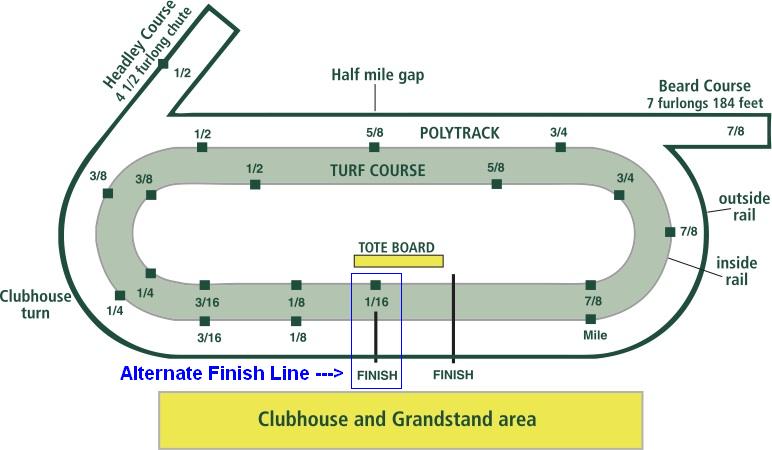Panning For Gold in the Keeneland Handicapping Database
Keeneland is a beautiful race course, set in the bucolic hills of Lexington, Kentucky. Each time we visit there we find something new. Unfortunately, we were unable to return there in the Spring of 2015, so the search for something new was limited to the internet … and sure enough, it was found. The Keeneland Handicapping Database.
Free to anyone with a computer and link to the internet, a database of 2,665 races run at Keeneland, from 2006 through the present. With one click, the information can be downloaded to a spreadsheet … and then sorted, sliced, and diced to your heart’s desire. And if you’ve been following this website for any length of time, you know that I can’t resist a little “Panning for Gold.” Below is a list of some of the data that’s available:
- Race Date and Number
- Race Meet (e.g. Spring 2015)
- Surface (Dirt, Turf, Polytrack)
- Distance (in furlongs)
- Field Size
- Post Position of Winning Horse
- Winning Horse Name
- Odds of Winning Horse
- Winning Trainer
- Winning Owner
- Winning Jockey
- Sire of Winner
- Half Mile Time
- Final Time
- Position of Winner at Half Mile Position
There is much more information, including details about prior starts, weather, and exotic payouts. Altogether a fine database for someone who likes to do a little trending analysis. With the change in surface on the main track from Polytrack to Dirt in the Fall of 2014, this is a great opportunity to look for any trend shifts that might be underway.
For our first trend study, we took a look at races run at the distance of 8.5 furlongs (11/16 miles) over the main track. In particular, given the shortened stretch for this distance, were there any differences between races run over the old Polytrack surface and the new Dirt surface?
Before we show the results, let’s back up a step for any readers that are unfamiliar with the layout of the Keeneland race track, and the unique nature of races run at 8.5 furlongs on the main track. Since Keeneland is an 8.5f oval, if these races ended at the normal finish line, they would have to start there as well, making for a very short run to the first turn after breaking from the gate. So rather than doing that, Keeneland officials decided to back up the start of the race by 1/2 furlong or 1/16 of a mile. This change necessitates they back up the finish line as well, creating an “Alternate Finish Line.” Below is a diagram of the track. We labeled the alternate finish line and drew a box around it.
With that background, now we ask the question: With a short stretch run, how important is it for horses to be close to the lead? To help answer this question, using the Keeneland database, we isolated winners at this distance and how close they were to the lead at the 1/2 mile position. The following chart shows winners that were within 1-length and 3-lengths of the lead.
Since the dirt surface is so new, the number of races run over the dirt surface is far less than those over the Polytrack surface. With that said, the present trend suggests that it’s far more important on dirt for a horse to have enough tactical speed to be close to the pace. In fact, 16% more winners were within 3-lengths of the lead on dirt, and 8% more were within 1-length.
We thought it might be interesting to contrast these results to similar distances run over the Turf course, where the finish line is located 1/16 of a mile further to the right, allowing horses a longer stretch run.
The results are nearly identical for both the 8f and 8.5f distances run over the turf course. You can see that it’s far less important for a horse to be within 1-length of the lead, with only a quarter of them winning from that position. The results for horses within 3-lengths is about the same as it was over the old Polytrack surface.
You should not make wagers based solely on one factor, like running style, but from these queries it seems reasonable to give a positive check mark to pacesetters and stalkers at 8.5f over the dirt course and stalkers and closers on the turf course at the 8 to 8.5 furlong distances.
With the Keeneland Spring meet in full bloom, we thought it might be interesting to review some statistics relating to the unique 2-year old (baby) races that are contested only at the Spring meets. The starting gate for these 4.5 furlong races is a chute visible in the upper left corner of the track diagram shown earlier in this article. There have been a total of 66 of theses races run since 2006.
The chart below shows the dominance of a handful of trainers in these races, with almost 40% won by one trainer, Wesley Ward.
We put an (*) next to the average Exacta payout for Todd Pletcher because it was skewed by one Exacta that paid $680 due to the 2nd place horse being 80-1 odds. If you remove that one from the data, the average Exacta payout for Todd Pletcher was $28.
As you can see, 47 of 66 races were won by one of only four trainers. The downside is the average win odds for these trainers was relatively low (9-5 to 7-2). With that said, it’s interesting that Exacta’s with Wesley Ward horses averaged over $50 … so maybe the key in these races is to uncover who will run second. As we’ve mentioned in other articles, sometimes you have to get creative when you’re dealing with heavy favorites, like most of Ward’s 2-year old horses are sure to be.
One last footnote on these 4.5f “baby” races: 64 of the 66 races were run over the now extinct Polytrack surface. It will be interesting to see if these trends hold steady as racing continues over the new dirt surface.
These are two examples of some of the information that can be gleaned from the Keeneland Handicapping Database. For those of you that are handy with spreadsheets, or have access to a database package, happy panning! Let us know if you find anything of interest.
![]()
By Neal Benoit






One comment on “Panning For Gold in the Keeneland Handicapping Database”